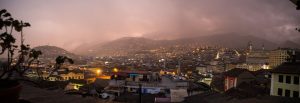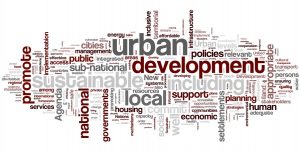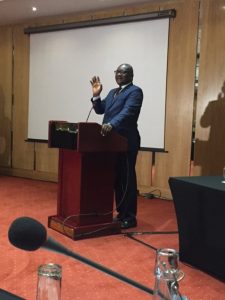Blog
Welcome to the age of anger
Eve Annecke’s TEDxtalk and TEDxCapeTownWomen
Eve Annecke talking at TEDxCapeTownWomen on becoming invisible, and how to be a worthy ancestor at the interface between a loving universe, her African roots and a world made mad by too much visibility. As is always the case with Eve, every word and every idea in this amazing talk is utterly original – something so rare in this world where social media has turned us into mass replicators of other people’s tropes. Redefining sustainability as the art of being a ‘worthy ancestor to the future’ is pure genius. It establishes a new way of anticipating the future that connects who we are, how we be in this world, and what the future could be. If forecasting is about predicting the future, and foresight is about compiling narratives of the future, then anticipatory thinking is about the evolutionary potential of the present, i.e. the future is connected to action in the ‘thick present’ (as Roberto Poli puts it). Eve’s talk is a brilliant rendition of this way of thinking-being.
Chinese growth and useless spaces
According to my colleague Serge Salat from Paris, as much as 40% of Chinese GDP growth is driven by investments in new buildings and associated infrastructure. However, there are now 80 million empty apartments. This bubble is going to burst, no doubt. But from a resource use perspective, this means up to 40% of Chinese growth that is, in turn, a major driver of global growth, is based on sinking money into cement. For the past 20 years over 50% of all cement use was in China. China used more cement in the three years 2011-2013 than the USA used in the whole of the c.20th. Cement demand in China is dropping, according to the largest cement company HolcimLaFarge. Mix all this together, add so political salt, and you get a looming crisis. Is anyone aware of the oncoming brick wall that Chinese growth is inevitably going to hit relatively soon?
Habitat III, Quito – reflections by a colleague
Habitat III, the United Nations Conference on Housing and Sustainable Urban Development, took the city of Quito, Equador, by storm from November 17 to 20, 2016, with attendees filling the Casa de la Cultura between Quito’s old city and the Mariscal. Paul Currie, a researcher with urban Modelling and Metabolism Assessment, the Centre for Complex Systems in Transition and the School of Public Leadership at Stellenbosch University, South Africa, participated in the conference and offers some reflections here:
Quito made a perfect setting for the conference, given its location in the global South, equipped with precarious cliffside housing, urban sprawl, limited highways, buses and cars spewing exhaust, an abundance of street vendors and a spectacular mountainous location in the midst of four active volcanoes. The concept of disaster resilience is quite apt, given the 1999 eruption of Pichincha volcano covered the city in ash. The city was also in the middle of it’s fiesta de la luz, drawing thousands of Ecuadorians to see the light shows projected on ornate churches – though such a description does no justice to the spectacle. As with any of these large events, the city takes on a new electric life and we’re left unsure if this is how it normally feels to wander Quito’s streets.
The conference drew together over 25000 single-day attendees of a rumored 45000 registrants. These attendees were united by a fascination with the form, processes and relationships of cities, and the starting point for most discussions was a unified acknowledgement that cities face challenges and that cities are the key to addressing global socio-economic and socio-ecological issues. From there, the points of divergence are the different language we use to describe these challenges, and the varied perspectives, approaches and agendas proposed to address them.
The 20-year latency between Habitat Conferences (The previous ones took place in Istanbul in 1996 and Vancouver in 1976), means that the global context has shifted drastically, and the world is in need of a renewed focus of its development priorities. This is seen by the recent concentration of mega-events that have resulted in the Paris Agreement, Sustainable Development Goals (SDGs) and the African Union’s Agenda 2063 to name a few.
Habitat III created a forum in which we could question together how cities have been developed, both as shining beacons of human ingenuity and creativity, and as structural enforcers of inequality and exclusivity. With this in mind, many note that the New Urban Agenda, the centerpiece of the conference, will not work if we overlook global and local inequity. The New Urban Agenda acknowledges a wide range of systemically discriminated groups including ‘women and girls, children and youth, persons with disabilities, people living with HIV/AIDS, older persons, indigenous peoples and local communities, slum and informal settlement dwellers, homeless people, workers, smallholder farmers and fishers, refugees, returnees and internally displaced persons, and migrants, regardless of migration status.’
While the NUA has a very clear desire to promote sustainable urban development, as visualised by the word cloud below, it is critiqued for not establishing its own targets or a means to measure the success of it’s many suggested interventions. What’s more, while it effectively stands as the embodiment of SDG Goal 11 to make cities and human settlements inclusive, safe, resilient and sustainable, it is very poorly connected to the goals and targets in the SDGs. This is highlighted as a missed opportunity by David Simon, of Mistra Urban Futures, in a conversation about the Habitat process. The power of cities as concentrators of people, welfare, innovation, as well as social diseconomies (crime, disease, poverty, inequality) and ecological impact, makes them the almost perfect levers for propelling global sustainability as embodied by many of the 17 SDGs. However, successful implementation of the NUA will be left to the interpretation of its broad rhetoric by local and national actors, many of whom are under-capacitated. Despite this, Simon explains that the NUA is the first UN document to ‘recognize the critical role of sub-national authorities and non-state actors’ – a major achievement for the UN system.
The Sunday before the conference began, a Mayors assembly shared voices from the heads of cities, which I felt set the tone for the conference and highlighted the varied nature of urban challenges and priorities worldwide:
Ban Ki Moon, Secretary General of the United Nations, challenges the Mayors to raise their voices to speak for their people.
Ada Colau, the Mayor of Barcelona shared enthusiasm that ‘the right to the city’ was incorporated in the NUA
Tri Rismaharisni, Mayor of Surabaya shared that ‘gender equity works for all,’ saying that gender parity will be the foundation of sustainable development.
Dennis Coderre, Mayor of Montreal argued the importance of local government, which is more engaged with people’s daily lives and needs, and called on national governments to realize the importance of cities and local authorities.
Miguel Angel Mancera, Mayor of Mexico City suggested that cities should receive funds directly without intermediaries.
Gustavo Baroja, Prefect of Pichincha, argued that we must break through the binary distinction of urban or rural as both are inter-reliant.
Michael Muller, Mayor of Berlin, asserts that we must turn the NUA from a piece of paper into actions, citing his challenge of bringing refugees from the periphery into the city.
Emil Elestianto Dardak, the Regent of Trenggalek, encourages us to adopt sustainable patterns of production and consumption.
Kumar Rai Bipin, of the Urban Board of Delhi, declares healthcare as a fundamental right and urges that slum areas are upgraded and not relocated.
Daniel Martinez, the Mayor of Montevideo, argues that we need a radical declaration of economic realities: that we will not achieve justice if we cannot address the lack of resources. Fighting for a social economy which redistributes wealth is a requirement for sustainability.
Mohamad Baqer Qualibaf, Mayor of Tehran says that ‘nobody can be a mayor if they are not in love with their city’ and motivates that cities should be constructed for their citizens
These desires were voiced in the buzz-words plastered around the conference, calling for cities that were sustainable, resilient, smart, participatory, inclusive, and in the multitudes of presentation and exhibitions throughout the conference.
With the adoption of the NUA, the global urban reality is unquestionable, and along with it, the manifestation of all urban challenges, intrigues, speed bumps. This is specifically important for African nations as before the Habitat III process, there was a prevailing denial among many governments on the continent that urbanization is happening, that it is caused by natural growth, or that it could deliver social and economic benefits. This denial may have been the most limiting obstacle facing urban practitioners, as urban policies would be missing vital tools, or focus primarily on anti- or de-urbanisation mechanisms. With acceptance of an urban reality, what now remains is for governments, through engagement with other stakeholders, to embed the ideas of the NUA in national agendas and develop local targets for developing just, sustainable cities.
Attending the 19th IRP Meeting in Paris
Sitting in the 19th meeting of the International Resource Panel in Paris, France. Best part about it is that my draft report Resource Requirements of Future Urbanization – sailed through the IRP and the Steerig Committeee. This means that subject to a few technical changes, it will now go forward to peer review and hopefully publication early next year. It has taken three years to compile this unique report, and I co-coordinated this team drawn from Berkeley, Paris, Utrecht, CSIRO in Australia, Minneapolis and Stellenbosch University. So exciting it has got this far. I think our key achievements were to quantify the resources required if the urban population doubles without any changes to the urban system, followed by chapters that suggest radical changes to densities, infrastructure and governance to promote an urban transition. Best session was a keynote by Tim Jackon from the UK – he seems to working on the intersection between material flows, psych-cultural behaviour that transcends individualism and consumerism, and most importantly of all a ‘post-growth macroeconomic’ paradigm. Very exciting stuff – worth checking out his Centre for Understanding Sustainable Prosperity.
Mphil colloquium – all welcome – programme attached
Debating innovation in African cities in Pretoria, where Zuma’s lawyers try to suppress the state capture report and the people respond in the streets
Sitting in what is called the Senior Experts Dialogue on Science, Technology and Innovation and the African Transformation Agenda organised by DST and the UN Economic Commission for Africa (UNECA). Premier David Makhura is delivering a great speech – emphasizing the importance of African cities as innovation hubs for driving the African structural transformation. He has integrated into his thinking about Gauteng all the key ideas from contemporary urbanism – often talking off script! This gives me hope, because here we are in a hotel in the CBD that is steadily filling up with protestors who have come to tell the South African President that he has no right to suppress the release of the state capture report. As Zuma’s lawyers help their client to take on his party and the people of South Africa and in so doing subvert our democracy, listening to Premier David Makhura gives me hope that there are still good political leaders who can rise up to fill the vaccuum when the ‘state capturers’ have been replaced. Even more inspiring is his grasp of the dynamics of the African city, and the growing significance of city leaders on the global stage. I guess with two metros in Gauteng now controlled by the SA, his life has become more complex and interesting. I will be talking later about city infrastructures and innovation in African cities.
Dignifying the art of cultural change at the Sustainability Institute
Our students are required to write a learning journal. This is submitted with their assignments 6 weeks after the week long contact module is completed. They are also required to do practical work for about an hour before class starts at 9.30 – one task being to sweep the floors of their classrooms to challenge the normal South African ethos of assuming that mess is cleaned by a black woman. An African woman student from a country north of the Limpopo wrote this beautifully poignant piece about her experience one morning with a white South African male who seemed reluctant to engage in what he regarded as woman’s work. This is her story:
“Morning work was extremely interesting today. Our group was assigned to sweep the inside of the main building. Whilst we were doing that, I noticed one of the guys from engineering class holding a broom on one hand and his telephone on the other. He continued like that for a while and I literally had to move around him in order to sweep. After a while I asked him if he was going to sweep any time soon and he said, and I quote “I don’t sweep, it’s a woman’s’ job”. Boy oh boy! My initial reaction was to get all “feminist” on him, instead I asked what he meant by that, and he said, well, I am here to get a degree and not to learn how to do household chores – that’s why you get a wife. Still trying to be patient, I asked if it was the actual sweeping that bothered him, or that he had to do it at school, to which he replied that it didn’t matter in what context it was, sweeping was sweeping and he had no business sweeping. He is not in my year so I asked if he was in last years’ PGDip group, but he is doing some engineering masters on main campus and taking Renewable Energy Finance as his elective. In the name of being accommodating I started asking him questions about himself, and what else he is doing, etc. As he was talking, and probably without realizing, he started moving his brush and sweeping with me. And he continued to do so until we finished. He only realized he had been sweeping when I asked if it was as bad as he had thought it was, after all. He looked shocked and could not believe he had actually been sweeping. So, I didn’t voice my opinion of his stereotyping of women or whatever. I could have done that, and would’ve probably ended up in a heated debate with him or whatever. Perhaps he has reason to think that way, and I didn’t feel like being the one to burst his bubble. Sure, I would revel to bang his head with a saucepan and talk of how women aren’t only good for household chores, but then what good will that do?”
2017 Intake – what could I teach her?
Reading applications for the 2017 intake I read this motivation for studying sustainable development in the application of a 22 year old black women from Nigel: “Development has for years been measured by the distance that exists between people and nature.” Wow, after that what could I possibly teach her?
CSIR research reveals why all South Africans must unite against the nuclear strategy
CSIR’s research shows that renewables cost 60c/kWh over the life cycle. This is half the cost of nuclear which is R1.20-R1.30 per kWk over the life cycle. The Renewable Energy Independent Power Producers Procurement Programme (REI4P) has already generated nearly R200 billion in 92 projects. Those have have been built have been built on time and within budget, which is definitely not the case with Medupi. A nuclear plant will take ten years, and they always cost more. The debate about nuclear is now quite simply about rands and cents: renewables are the cheapest. They can also deliver baseload if they are geographically distributed on a large scale. Also, salt batteries can give Concentrated Solar Power plants storage capacity of up to 14 hours if so needed. In short, if we are really interested in a diversified innovation-driven economy, we must scrap the idea of nuclear and invest in renewables. This is NOT what the soon to be released IRP will say: the new IRP will have been written to just the need for nuclear because there are powerful forces who have already decided that nuclear is best. ESKOM has mounted a PR campaign against renewables. This needs to be countered on a daily basis by as many people as possible. The CSIR report provides the basis for this campaign. 





Recent Comments